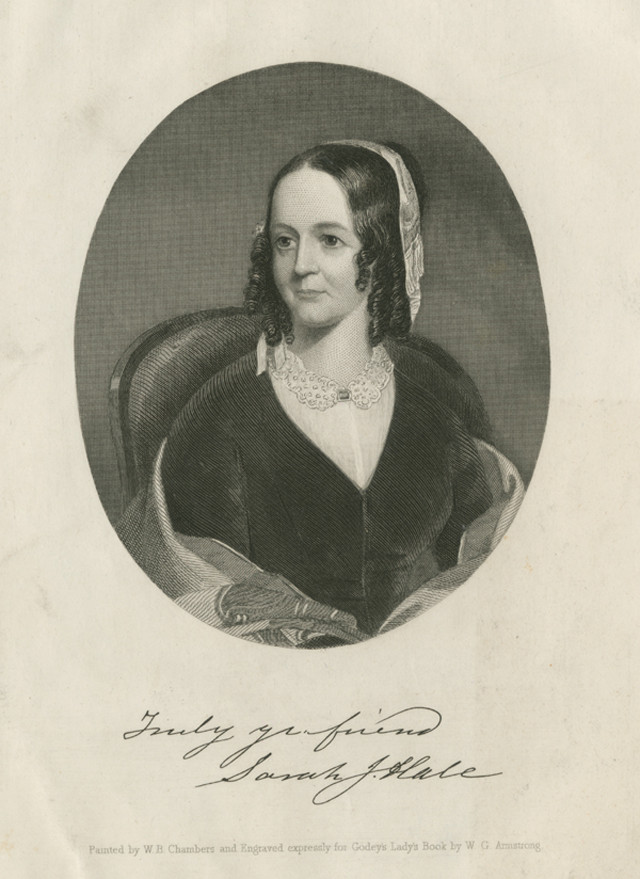
by John Copeland Friday, October 23, 2015

Frontispiece from issue 41 of Godey's Lady's Book (1850) featuring engraving of editor Sarah Josepha Hale. Credit: Public Domain.
In America, we are approaching Thanksgiving, a time when we gather with family, friends and loved ones to celebrate and give thanks. We are also sharing a moment with our distant ancestors. Throughout human history, virtually every culture has celebrated harvest, including ancient Greeks, Romans, Hebrews, Persians, Chinese, Egyptians, Celts and Native Americans, among others. Our contemporary Thanksgiving is related in spirit to every one of those ancient festivals. But have you ever wondered how Thanksgiving came to be celebrated on the fourth Thursday of November?
Several historical events vie for the title of the “First American Thanksgiving.” Although they remain topics of contention, these occasions all share one thing in common: They all celebrated survival in a strange new land.
The traditional “first Thanksgiving” most of us are familiar with is the one held at Plymouth Plantation. After barely surviving their first year in America, thanks to the help of local Native Americans, the Plymouth colonists’ first harvest was successful and ample, and there was reason to celebrate. The surviving original 50 colonists and 91 Native Americans celebrated the harvest together in October 1621. In the decades following, nearly every American colony observed its own days of thanksgiving. These early thanksgivings were solemn days of prayer and fasting.
During the American Revolution, the Continental Congress issued a First National Proclamation of Thanksgiving in 1777 to celebrate the colonists’ victory over the British at Saratoga. In 1789, President George Washington proclaimed a day of thanksgiving partly to honor ratification of the United States Constitution. These thanksgivings were patriotic in nature.
Then, along came Sarah Josepha Hale, a truly fascinating woman who forever changed the face of Thanksgiving as we know it. Widowed and penniless at 34, with five small children to provide for, Sarah turned to writing to support her family. She co-published a book of poetry, wrote a successful novel and went on to publish more than 50 works, including one of the best-known nursery rhymes, “Mary Had A Little Lamb.” Based on her success, she was hired as editor of American Ladies Magazine, the first women’s magazine in America. She eventually became the editor of Godey’s Lady’s Book. Under her guidance, Godey’s became the most widely read magazine of the 19th century and Hale one of America’s most influential voices.
Hale campaigned for more than 20 years to establish a Thanksgiving Day as a national holiday in the United States. Beginning with Zachary Taylor, she petitioned each sitting president, all of whom ignored her entreaties. In the fall of 1863, she wrote to President Lincoln. The balance of the Civil War had shifted that year as a result of the Union’s victories at Gettysburg and Vicksburg and Lincoln’s Emancipation Proclamation. On Oct. 3, 1863, Lincoln called on Americans to set aside and observe the last Thursday of November as a day of thanksgiving. Until Lincoln’s declaration, the only national holidays celebrated in America were Washington’s Birthday and Independence Day.
There is no official evidence that Hale’s letter caused Lincoln to make this declaration, though it’s hard to believe it didn’t play a role in the establishment of a national holiday. And she wasn’t yet done with Thanksgiving.
Hale changed the way elementary school children learned about the meeting between the English colonists and the Wampanoag Indians. Prior to her great campaign for the holiday — which had long been celebrated in New England but not throughout the rest of the country — the romanticized story of the first Thanksgiving as told today was unknown. In 1865, when Hale described in Godey’s the first Thanksgiving as a celebratory feast between the pilgrims and the Native Americans, the story spread like wildfire. It was reproduced in numerous other magazines and newspapers. It only took five years from the time her article appeared for this story of Thanksgiving to be taught in schools and included in textbooks. Over the next few decades, the story served as the perfect way to teach newly arriving immigrants about America’s history. Although not historically accurate, the story has stuck with us over the years.
In 1939, President Franklin D. Roosevelt declared that Thanksgiving would be celebrated on the fourth Thursday of November rather than the last Thursday. The United States was still in the midst of the Great Depression and Roosevelt thought that giving merchants longer to sell goods before Christmas would help the country recover.
Today, our U.S. Thanksgiving tradition invokes the meal held by the Plymouth colonists and Native Americans celebrating harvest and survival together as its inspiration. But it took the trauma of the Civil War for Thanksgiving to be set aside as a formal, annual holiday to observe the many blessings our land and country have offered us.
© 2008-2021. All rights reserved. Any copying, redistribution or retransmission of any of the contents of this service without the expressed written permission of the American Geosciences Institute is expressly prohibited. Click here for all copyright requests.